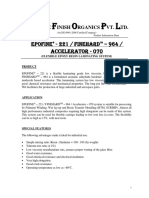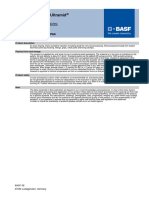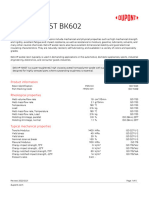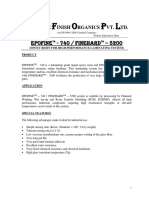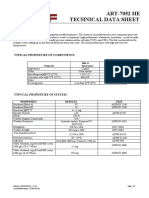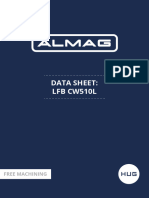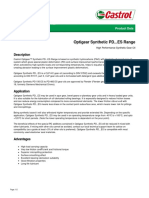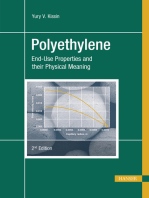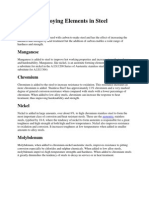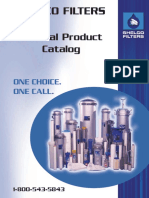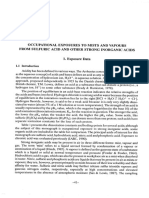CGH alumina catalyst-14pages_11
CGH alumina catalyst-14pages_11
Uploaded by
dianwei.zeoliteCopyright:
Available Formats
CGH alumina catalyst-14pages_11
CGH alumina catalyst-14pages_11
Uploaded by
dianwei.zeoliteCopyright
Available Formats
Share this document
Did you find this document useful?
Is this content inappropriate?
Copyright:
Available Formats
CGH alumina catalyst-14pages_11
CGH alumina catalyst-14pages_11
Uploaded by
dianwei.zeoliteCopyright:
Available Formats
Key Property of Activated Alumina Adsorbents For Compressed Air Drying
Typical Property Product Code
Activated Alumina
Al2O3
A300 A300 A300 A300
2-3mm 3-4mm 4-5mm 6-7mm
Chemical Data Al2O3 % 92.7 92.7 92.7 92.7
Na2O % <0.45 <0.45 <0.45 <0.45
SiO2 % <0.02 <0.02 <0.02 <0.02
Fe2O3 % <0.02 <0.02 <0.02 <0.02
LOI % 7 7 7 7
Physical Data Surface Area mm2/g >300 >300 >300 >300
Pore Volume ml/g >0.4 >0.4 >0.4 >0.4
Bulk Density g/ml 0.77 0.77 0.77 0.77
Crush Strength N/pc 50 140 250 320
Abrasion Loss % <0.1 <0.1 <0.1 <0.1
Equilibrium Capacity % 30 30 30 30
for water vapor 25℃ at Humidity 80%
Desorption Tem ℃ 170-200 170-200 170-200 170-200
Pressure Dew Point ℃ - 40 - 40 - 40 - 40
How to choose your adsorbents?
Cold regenerated (heatless) Cold-regenerated dryers (so-called heatless driers) function without heat but with a lot of
compressed air. These pressure swing adsorption dryers require a partial flow of previously-dried air for regeneration. The
changeover takes place after only a few minutes with low water adsorption of less than 1 % by weight of the drying agent.
Due to the high consumption of 12 to 25 % dried compressed air depending on the operating pressure, relatively high
energy costs result during operation.
Pressure dew point: -25 to -40 °C, Adsorbent: Activated Alumina
Pressure dew point: -70 °C 1F 200, Molecular Sieve 4A
External heat regenerated (standard) Standard adsorption dryers (externally heat-regenerated) are desorbed with
externally heated fan air like the lowenergy variants. These are used if the demands on the efficiency are not too high. In
contrast to the modern purgeless systems, a partial flow of compressed air (purge air) is normally required for cooling. The
standard of these systems usually includes drying agents which require a significantly higher desorption temperature (170°
to 200 °C.) and a larger quantity of dry regeneration air.
Pressure dew point: -25 to -40 °C Adsorbent: Activated Alumina
www.aluminacatalyst.com
11
You might also like
- CGH alumina catalyst-14pages_12Document1 pageCGH alumina catalyst-14pages_12dianwei.zeoliteNo ratings yet
- Gophin Chemical Co., LTD: DatasheetDocument3 pagesGophin Chemical Co., LTD: DatasheetmadhudNo ratings yet
- Pa66-G30 Ahbk003 Tds-Iso-EngDocument2 pagesPa66-G30 Ahbk003 Tds-Iso-EngVinoth SekarNo ratings yet
- Product Specifications Hydrate2018Document6 pagesProduct Specifications Hydrate2018Jayakumar ANo ratings yet
- Specification Hydrate FinalDocument6 pagesSpecification Hydrate FinalSanjayNo ratings yet
- Transparent ABS: Mabs: Toray Plastics (Malaysia) Sdn. BNDDocument6 pagesTransparent ABS: Mabs: Toray Plastics (Malaysia) Sdn. BNDTungdinh NguyenNo ratings yet
- Corning Fused Silica 7980Document4 pagesCorning Fused Silica 7980Mandi IndarsNo ratings yet
- Optimus Turbine Oil 2Document1 pageOptimus Turbine Oil 2kennethNo ratings yet
- Activated Alumina Technical Data Sheet From XintaoDocument2 pagesActivated Alumina Technical Data Sheet From XintaoHafiz FebrianaNo ratings yet
- Typical Properties: "Much More Viscous Than Brightstocks, and Bio-Based"Document1 pageTypical Properties: "Much More Viscous Than Brightstocks, and Bio-Based"MarcinNo ratings yet
- Hopelex Af 3100Document2 pagesHopelex Af 3100FarizNo ratings yet
- Compressed Air TreatmentDocument46 pagesCompressed Air TreatmentPietro ChiocchiNo ratings yet
- SGL Datasheet SIGRAFINE Materials For Mechanical Applications ENDocument2 pagesSGL Datasheet SIGRAFINE Materials For Mechanical Applications ENMayur PattanshettiNo ratings yet
- Silicone Fluids Stable Inert MediaDocument32 pagesSilicone Fluids Stable Inert MediachayanunNo ratings yet
- Bpxe 94LVSTDocument2 pagesBpxe 94LVSTAriel JuarezNo ratings yet
- Precipitated SilicaDocument5 pagesPrecipitated SilicaLong An ĐỗNo ratings yet
- FJ Product Data Hydraulic Wiper Seal Beca 485 037253700 1631 08122015Document5 pagesFJ Product Data Hydraulic Wiper Seal Beca 485 037253700 1631 08122015Phan Đức NgọcNo ratings yet
- KNG1015 Pa6-Gf15Document2 pagesKNG1015 Pa6-Gf15pava16230.meNo ratings yet
- DUPAC-0521®: DescriptionDocument6 pagesDUPAC-0521®: DescriptionPablo TorresNo ratings yet
- Nextel Ceramic Fiber Typical Properties: 3M Property Units Nextel™ 312 Nextel™ 440 Nextel™ 550Document2 pagesNextel Ceramic Fiber Typical Properties: 3M Property Units Nextel™ 312 Nextel™ 440 Nextel™ 550ninatenaNo ratings yet
- Epofine 221 - Finehard 964 - Accelerator 070Document4 pagesEpofine 221 - Finehard 964 - Accelerator 070Karishma PrabhuNo ratings yet
- P GSL N Filter ElementsDocument4 pagesP GSL N Filter ElementsHUY TINNo ratings yet
- Sasol HNR100Document2 pagesSasol HNR100brandon abella gutierrezNo ratings yet
- Granulated Wool CatalogueDocument5 pagesGranulated Wool CatalogueRaihan AhmedNo ratings yet
- ADHESIET 180 P Dry Air Setting Refractory MortarDocument1 pageADHESIET 180 P Dry Air Setting Refractory MortarPranabesh MallickNo ratings yet
- Technical Data of Vacuum Formed Ceramic FiberDocument2 pagesTechnical Data of Vacuum Formed Ceramic Fiberba ajinNo ratings yet
- Technical Data of Vacuum Formed Ceramic Fiber PDFDocument2 pagesTechnical Data of Vacuum Formed Ceramic Fiber PDFba ajinNo ratings yet
- Ultramid® B3S en SIDocument2 pagesUltramid® B3S en SImuamerNo ratings yet
- Productdatasheet en t20 Dc5673048aDocument5 pagesProductdatasheet en t20 Dc5673048aElisson MunizNo ratings yet
- Delrin® 100ST BK602-enDocument5 pagesDelrin® 100ST BK602-enjunzo.kinoNo ratings yet
- Epofine 740 - Finehard 5200Document4 pagesEpofine 740 - Finehard 5200Karishma PrabhuNo ratings yet
- Jna 33Document1 pageJna 33jaskaran singhNo ratings yet
- Timfold Product Page PDFDocument2 pagesTimfold Product Page PDFVlado KaucicNo ratings yet
- ART-7052 HE Technical Data Sheet: DescriptionDocument4 pagesART-7052 HE Technical Data Sheet: Descriptionfrancisca ferrerNo ratings yet
- BSS All Products Spec Sheet UDocument35 pagesBSS All Products Spec Sheet UJoe Dana PhilipNo ratings yet
- Econamid FL 6B30Document2 pagesEconamid FL 6B30Jagadeesh WaranNo ratings yet
- G65 Data Sheet: PropertiesDocument6 pagesG65 Data Sheet: PropertiesNicko RizqienggalNo ratings yet
- Rod Seal: DesignDocument7 pagesRod Seal: Designgamal abousamraNo ratings yet
- Das TDS - Ma PDSDocument2 pagesDas TDS - Ma PDSIMRAN KHANNo ratings yet
- Technisches Datenblatt g40 EngDocument5 pagesTechnisches Datenblatt g40 EngEd LiewNo ratings yet
- 4 30 TDS Yellow3920M-Micronized IronOxideYellow Pigment-GreefieldDocument1 page4 30 TDS Yellow3920M-Micronized IronOxideYellow Pigment-GreefieldGreefield JasonNo ratings yet
- Aeroshell Fluid 71Document2 pagesAeroshell Fluid 71mertaktayNo ratings yet
- Cortis ZSDocument1 pageCortis ZSAbdul BasitNo ratings yet
- TDS Hipersite W7000Document1 pageTDS Hipersite W7000It WittayaNo ratings yet
- NYLON 630G Black Data sheetDocument1 pageNYLON 630G Black Data sheetVeeraNo ratings yet
- AKROMID B28 GF 50 1 GIT Black (4732)Document4 pagesAKROMID B28 GF 50 1 GIT Black (4732)maria.goncalvesNo ratings yet
- TDS Nuoc Lam Mat BASF Glysantin G 48 ENDocument5 pagesTDS Nuoc Lam Mat BASF Glysantin G 48 ENSPTC CORPNo ratings yet
- ADNOC EP GreaseDocument1 pageADNOC EP GreaseVSNo ratings yet
- Adnoc Grease EpDocument1 pageAdnoc Grease EpEMADNo ratings yet
- Foodmax Grease CAS S 2 LS - TDS - 263701301 - ENDocument2 pagesFoodmax Grease CAS S 2 LS - TDS - 263701301 - ENDeath Heart100% (1)
- PTFE HY538 HoerbigerDocument1 pagePTFE HY538 HoerbigerТатьяна ВасильеваNo ratings yet
- LFBCW510L TN enDocument4 pagesLFBCW510L TN endrgilleNo ratings yet
- Bpxe B6ctalDocument2 pagesBpxe B6ctalVusal HasanovNo ratings yet
- (Ems) (TDS) Grilamid TR 90 LXDocument4 pages(Ems) (TDS) Grilamid TR 90 LXMarcos KodairaNo ratings yet
- FT - Longtime PD RangeDocument2 pagesFT - Longtime PD RangeRonald Mario Kupa AnticonaNo ratings yet
- CZLLCW511L TN enDocument4 pagesCZLLCW511L TN endrgilleNo ratings yet
- Amine ODocument8 pagesAmine OLuis Alberto ChavezNo ratings yet
- FP - EN - GreenFlux 400 - LM - 0909 - 4Document1 pageFP - EN - GreenFlux 400 - LM - 0909 - 4tribolasNo ratings yet
- Module 3 - 1Document26 pagesModule 3 - 1Biswajit LME016100% (1)
- Practical 1: Study of Laboratory Reagents: A SolutionDocument17 pagesPractical 1: Study of Laboratory Reagents: A SolutionPalNo ratings yet
- BS en 10002-5-1992 (1999)Document33 pagesBS en 10002-5-1992 (1999)Sainath AmudaNo ratings yet
- Lipids ActivityDocument2 pagesLipids ActivityTrixie Delos Reyes BuñoNo ratings yet
- Learn by Heart IB Biology A1.1 SL HL 2 Activity Bundle Matching Activity Flashcard CreatorDocument8 pagesLearn by Heart IB Biology A1.1 SL HL 2 Activity Bundle Matching Activity Flashcard Creatoranitabananita2220No ratings yet
- Cirrus: Standard RepairsDocument10 pagesCirrus: Standard Repairsengine wangNo ratings yet
- Q/SQR: Enterprise Standard of Chery Automobile Co., LTDDocument22 pagesQ/SQR: Enterprise Standard of Chery Automobile Co., LTDDiego CamargoNo ratings yet
- Effects of Alloying Elements in SteelDocument3 pagesEffects of Alloying Elements in SteelRudraman Singh0% (1)
- General Product Catalog: Shelco FiltersDocument48 pagesGeneral Product Catalog: Shelco FiltersMarco CocchiNo ratings yet
- Sulphuric Acid Mono54-6Document89 pagesSulphuric Acid Mono54-6werdna67No ratings yet
- Fusion Bonded Joint - A Fatigue Friendly Connector For Cost Efficient Plastic Lined Pipe Installation and OperationDocument16 pagesFusion Bonded Joint - A Fatigue Friendly Connector For Cost Efficient Plastic Lined Pipe Installation and OperationMubeenNo ratings yet
- Carbopol Ultrez 21 Hoja TecnicaDocument4 pagesCarbopol Ultrez 21 Hoja Tecnicalujocafe7No ratings yet
- Enzyme Lab ReportDocument10 pagesEnzyme Lab Reportapi-460642080No ratings yet
- Vviscose Dtex Yarn Test ReportDocument3 pagesVviscose Dtex Yarn Test ReportN.M. EESWARANNo ratings yet
- NanodevicesDocument20 pagesNanodevicesHemanth Achamveedu75% (8)
- 1.2.3 Retouch-RepairDocument2 pages1.2.3 Retouch-Repairsyed.farooqNo ratings yet
- Module 1Document31 pagesModule 1Carms GameNo ratings yet
- TNT 12 Tech BulletinDocument5 pagesTNT 12 Tech BulletinandyNo ratings yet
- EDUCTORSDocument2 pagesEDUCTORSakhmad saefulNo ratings yet
- CORBEL (NIP Design)Document4 pagesCORBEL (NIP Design)Ashraf Abu-mahfoudNo ratings yet
- Week4HW S15 Solutions PDFDocument10 pagesWeek4HW S15 Solutions PDFSamarjeet Kumar SinghNo ratings yet
- Pipeline Coating Specifiation and RehabilitationDocument78 pagesPipeline Coating Specifiation and RehabilitationArabian Industries India Pvt LtdNo ratings yet
- DEMU COUP - Leviat - 17 1 EDocument28 pagesDEMU COUP - Leviat - 17 1 EJianhua WuNo ratings yet
- Post-Tensioning Format For Pc-Girder General InformationDocument1 pagePost-Tensioning Format For Pc-Girder General InformationTirthajit RoyNo ratings yet
- Book TextDocument18 pagesBook Textandirio7486No ratings yet
- Valence Electrons For ElementsDocument31 pagesValence Electrons For ElementsVinluan, Kaye Andrei P.No ratings yet
- Types of OxideDocument1 pageTypes of OxideTamoya ShirleyNo ratings yet
- Soil ProblemsDocument3 pagesSoil ProblemsYss CastañedaNo ratings yet
- ET-3000.00-1500-251-PEK-001 - INDocument27 pagesET-3000.00-1500-251-PEK-001 - INLuan OliveiraNo ratings yet
- Technologies and Services - Bisphenol A BPA - BadgerDocument3 pagesTechnologies and Services - Bisphenol A BPA - BadgerAdrian LemosNo ratings yet




















